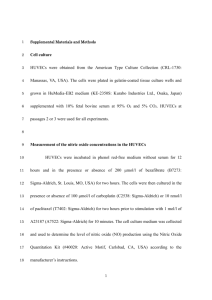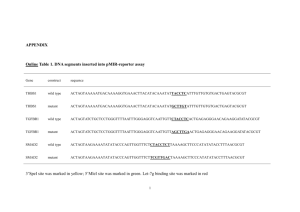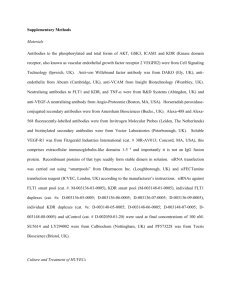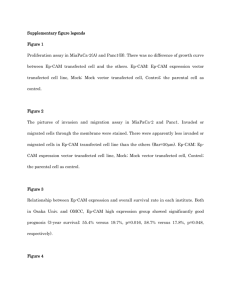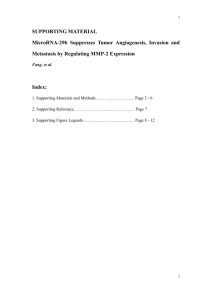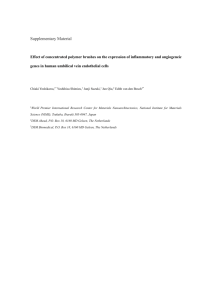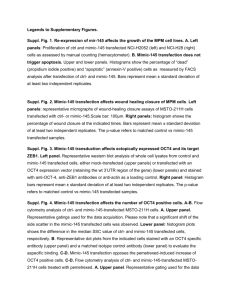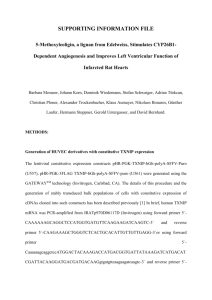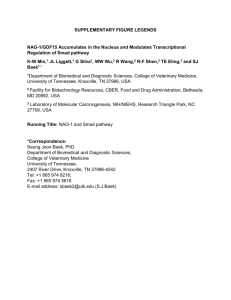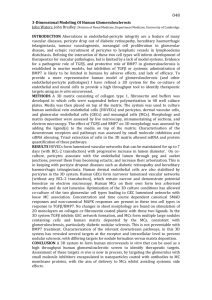Supplementary data for A new microRNA signal pathway regulated
advertisement
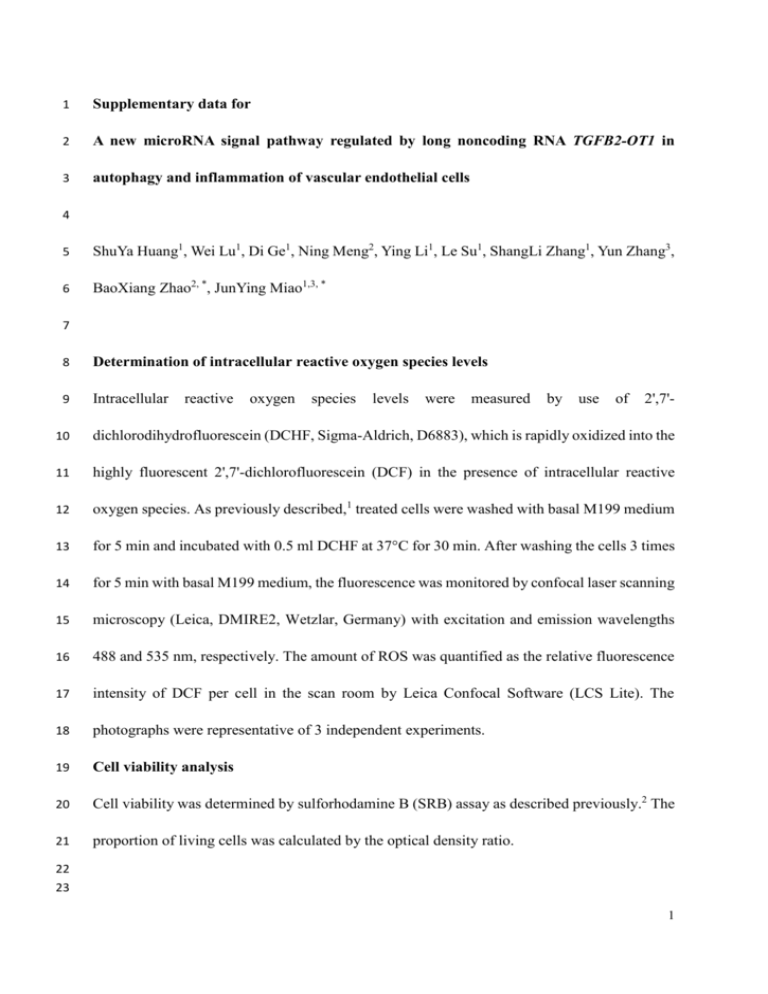
1 Supplementary data for 2 A new microRNA signal pathway regulated by long noncoding RNA TGFB2-OT1 in 3 autophagy and inflammation of vascular endothelial cells 4 5 ShuYa Huang1, Wei Lu1, Di Ge1, Ning Meng2, Ying Li1, Le Su1, ShangLi Zhang1, Yun Zhang3, 6 BaoXiang Zhao2, *, JunYing Miao1,3, * 7 8 Determination of intracellular reactive oxygen species levels 9 Intracellular reactive oxygen species levels were measured by use of 2',7'- 10 dichlorodihydrofluorescein (DCHF, Sigma-Aldrich, D6883), which is rapidly oxidized into the 11 highly fluorescent 2',7'-dichlorofluorescein (DCF) in the presence of intracellular reactive 12 oxygen species. As previously described,1 treated cells were washed with basal M199 medium 13 for 5 min and incubated with 0.5 ml DCHF at 37°C for 30 min. After washing the cells 3 times 14 for 5 min with basal M199 medium, the fluorescence was monitored by confocal laser scanning 15 microscopy (Leica, DMIRE2, Wetzlar, Germany) with excitation and emission wavelengths 16 488 and 535 nm, respectively. The amount of ROS was quantified as the relative fluorescence 17 intensity of DCF per cell in the scan room by Leica Confocal Software (LCS Lite). The 18 photographs were representative of 3 independent experiments. 19 Cell viability analysis 20 Cell viability was determined by sulforhodamine B (SRB) assay as described previously.2 The 21 proportion of living cells was calculated by the optical density ratio. 22 23 1 1 Table S1. List of primer sequences. Primer name Sequence (5’ to 3’) SQSTM1.F CTGCCTTCTTCCAGGATCAG SQSTM1.R GTGAAAGCCATTAGGCAAGC CERS1.F GCTGTTTGGCACCGACTACC CERS1.R GGAGGAGACGATGAGGATGAGAG NAT8L.F GCTGTGCTTCGCCGTGAG NAT8L.R ACCGTGTTGTCCTCCTCGTG LARP1.F GGTTCCAGCAAGTTCCTAC LARP1.R ATCCAGTGTCCGTCCTTC IL1B.F GAGGCACAAGGCACAACAG IL1B.R TAGTGGTGGTCGGAGATTCG 2 3 Supplemental results 4 Table S2. The top 5 miRNAs can bind TGFB2-OT1 with significantly changed levels on 5 miRNA arrays. 6 7 A2 vs. A1 represents the changed ratio induced by 120 μM 3BDO in HUVECs for 24 h. B2 vs. 8 B1 represents the changed ratio induced by TGFB2-OT1 overexpression in HUVECs for 24 h. 2 1 The free energy represents the predicted binding ability of miRNA with TGFB2-OT1. 2 3 4 Figure S1. The miRNA array results and the efficiency of TIA1 knockdown. (A) Differentially 5 expressed microRNAs (miRNAs) induced by 120 μM 3BDO in human umbilical vein 6 endothelial cells (HUVECs) for 24 h. Depicts miRNAs with >2-fold change in expression: 7 upregulation (red) and downregulation (green). The black plots indicated miRNA expression 8 changed < 2-fold. (B) Differentially expressed miRNAs induced by TGFB2-OT1 9 overexpression in HUVECs for 24 h. Depicts miRNAs with >2-fold change in expression: 10 upregulation (red) and downregulation (green). The black plots indicate miRNAs with < 2-fold 11 change in expression. (C) Western blot analysis of TIA1 protein level in HUVECs subjected 12 to scrambled siRNA (Scr) or TIA1 siRNA (siTIA1, 40 nM) for 24 h, then treated with 1 μg/ml 13 LPS for 6 h. *, P < 0.05; **, P < 0.01; n = 3. 3 1 2 Figure S2. The potential binding sites of MIR3960 and MIR4488 in TGFB2-OT1 and the target 3 genes of these 2 miRNAs. (A) Potential sites in Luc-TGFB2-OT1 targeted by MIR3960. 4 TGFB2-OT1 fragments and mutant derivatives devoid of binding-site fragments were cloned 5 into the luciferase reporter vector, for in 2 constructs, Luc-TGFB2-OT1-WT and Luc-TGFB2- 6 OT1-3960Δ. (B) Potential sites in Luc-TGFB2-OT1 targeted by MIR4488. TGFB2-OT1 7 fragments and mutant derivatives devoid of MIR4488 binding-site fragments were cloned into 8 the luciferase reporter vector, for 2 constructs, Luc-TGFB2-OT1-WT and Luc-TGFB2-OT1- 9 4488Δ. (C) Potential sites in the 3’UTR of CERS1, NAT8L and LARP1 targeted by MIR3960, 10 MIR4488 and MIR4459, respectively. The 3’UTR of CERS1, NAT8L and LARP1 within the 11 binding sites were cloned into the luciferase reporter vector, for 3 constructs, Luc-CERS1- 12 3’UTR, Luc-NAT8L-3’UTR and Luc-LARP1-3’UTR. 4 1 2 Figure S3. The transfection efficiency and effects on target genes of the miRNA mimics and 3 inhibitors. (A) qPCR analysis of levels of MIR3960 and MIR4488 in HUVECs transfected with 4 different concentrations of MIR3960 and MIR4488 mimics or inhibitor, respectively. (B) qPCR 5 analysis of mRNA levels of CERS1 and NAT8L in HUVECs transfected with different 6 concentrations of MIR3960 and MIR4488 mimics or inhibitor, respectively. *, P < 0.05; **, P 7 < 0.01; n = 3. 8 5 1 2 Figure S4. The effect of 3BDO on the mRNA levels of CERS1, LARP1 and NAT8L. (A) qPCR 3 analysis of mRNA level of CERS1 of HUVECs treated with 3BDO (0, 15, 30, 60 and 120 μM) 4 for 12 h. (B) qPCR analysis of mRNA levels of LARP1 and NAT8L in HUVECs treated with 5 3BDO (0, 15, 30, 60 and 120 μM) for 24 h. *, P < 0.05; **, P < 0.01; n = 3. 6 1 2 Figure S5. The effect of TGFB2-OT1 overexpression on ATG3 and ATG7 protein levels. 3 Western blot analysis of ATG3 and ATG7 protein levels in HUVECs transfected with 0.01, 4 0.02, 0.1, 0.2 μg/ml of pCMV6 or pCMV6-TGFB2-OT1 for 48 h and quantification. **, P < 5 0.01; n = 3. 7 Relative SQSTM1 mRNA level Relative SQSTM1 mRNA level 1 2 3 Figure S6. 3BDO affects SQSTM1 protein level rather than mRNA level. (A) qPCR analysis 4 of SQSTM1 mRNA level in HUVECs transfected with 0.1, 0.2, 0.4 μg/ml of pCMV6 or 5 pCMV6-TGFB2-OT1 for 48 h. (B) Western blot analysis of SQSTM1 protein level in HUVECs 6 transfected with pCMV6 or pCMV6-TGFB2-OT1 for 24 h, then treated with or without 3BDO 7 (60 μM) for 6 h. (C) qPCR analysis of SQSTM1 mRNA level in HUVECs exposed to 50 μg/ml 8 oxLDL with and without 3BDO (3BDO-L, 60 μM; 3BDO-H, 120 μM) for 12 h. *, P < 0.05; n 9 = 3. 8 1 2 Figure S7. The effect of TGFB2-OT1 overexpression on NFKB RELA nuclear translocation, 3 cell viability and reactive oxygen species levels. (A) Percentage of NFKB RELA nuclear 4 translocation in HUVECs transfected with 0.4 μg/ml of pCMV6 or pCMV6-TGFB2-OT1 5 respectively for 48 h. (B) Percentage of NFKB RELA nuclear translocation in HUVECs 6 transfected with pCMV6, pCMV6-TGFB2-OT1, or both siRNA against SQSTM1 and pCMV6- 7 TGFB2-OT1 respectively for 48 h. (C) Relative ratio of cells with to without NFKB RELA 8 nuclear translocation in HUVECs transfected with pCMV6, pCMV6-TGFB2-OT1, or both 9 siRNA against SQSTM1 and pCMV6-TGFB2-OT1 respectively for 48 h. (D) Cell viability was 10 detected by SRB in HUVECs transfected with 0.4 μg/ml of pCMV6 or pCMV6-TGFB2-OT1 11 for 48 or 72 h, and then exposed with 3BDO (60 μM) for 12 h. (E) Intracellular reactive oxygen 12 species levels examined by 2',7'-dichlorodihydroluorescein (DCHF). For reactive oxygen 13 species levels in HUVECs, the cells were transfected with 0.1, 0.4 μg/ml of pCMV6-TGFB2- 14 OT1 or 0.4 μg/ml pCMV6 for 24 h. Nor, normal HUVECs without any treatment. **P < 0.01, 15 n = 3. 9 1 2 Figure S8. The effect of lncRNA LOC100129973 on SQSTM1 protein level and NFKB RELA 3 nuclear translocation. (A) Western blot analysis of SQSTM1 protein level in HUVECs 4 transfected with 0.01, 0.05, 0.1 and 0.2 μg/ml of pcDNA or pcDNA-LOC100129973 for 48 h. 5 (B) Immunofluorescence staining of SQSTM1 in HUVECs transfected with pcDNA or 6 pcDNA-LOC100129973 (0.2 μg/ml) for 48 h. Bar: 16 μm. (C) Western blot analysis of 7 SQSTM1 protein level in HUVECs transfected with pcDNA or pcDNA-LOC100129973 (0.2 8 μg/ml) for 12 h, and then treated with or without cycloheximide (CHX) for 12 h. *P < 0.05, n 9 = 3. (D) Representative photomicrographs of immunofluorescence staining showing NFKB 10 RELA nuclear translocation in HUVECs transfected with pcDNA or pcDNA-LOC100129973 11 (0.4 μg/ml) respectively for 48 h. DAPI represent the nuclear. Bar: 16 μm. 10 1 References 2 1. Wang L, Dong Z, Huang B, Zhao B, Wang H, Zhao J, Kung H, Zhang S, Miao J. Distinct patterns of 3 autophagy evoked by two benzoxazine derivatives in vascular endothelial cells. Autophagy 2010; 4 6:1115-24. 5 6 2. Liu YR, Luo JZ, Duan PP, Shao J, Zhao BX, Miao JY. Synthesis of pyrazole peptidomimetics and their inhibition against A549 lung cancer cells. Bioorganic & medicinal chemistry letters 2012; 22:6882-7. 7 8 11
